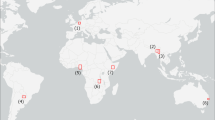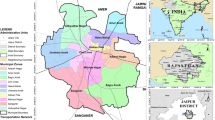Abstract
From a disaster relief perspective, an immediate and efficient rescue operation after an earthquake can greatly increase the number of survivors. An effective rescue operation depends on two key elements: localisation of the affected areas and estimation of the number of casualties in these areas. Many more studies have been conducted on the localisation of affected areas than on casualty estimation. Consequently, this study develops a model for rapidly estimating the number of casualties using satellite remote sensing (SRS). The model is based on the attributes of damaged buildings, as these buildings cause the greatest harm to inhabitants and they can be detected by SRS. The model uses the damage index (DI) of buildings computed by a numerical damage model derived from SRS images to assess the extent of damage. The DI is then combined with the building’s materials and structure index, which is calculated using information from the local geographic information system, to compute the joint casualty index (JCI). Finally, the number of casualties is estimated by the product of the JCI multiplied by the number of people inside the damaged buildings at the time of the earthquake. The model is then applied to three towns in Dujiangyan City, as these were the areas that most severely affected by the Wenchuan earthquake. Preliminary results showed that there was little difference between the actual and estimated number of casualties. It is recommended that more casualty data should be included in the model to improve the accuracy of estimation.







Similar content being viewed by others
References
Alobeid A, Jacobsen K, Heipke C (2010) Comparison of matching algorithms for DSM generation in urban areas from Ikonos imagery. Photogramm Eng Rem S 76:1041–1050
Balz T, Liao MS (2010) Building-damage detection using post-seismic high-resolution SAR satellite data. Int J Remote Sens 31:3369–3391
Beck LR, Lobitz BM, Wood BL (2000) Remote sensing and human health: new sensors and new opportunities. Emerg Infect Dis 6:217–227
Birchfield S, Tomasi C (1999) Depth discontinuities by pixel-to-pixel stereo. Int J Comput Vision 35:269–293
Blong R (2003) A new damage index. Nat Hazards 30:1–23
Brunner D, Bruzzone L, Lemoine G (2010) Change detection for earthquake damage assessment in built-up areas using very high resolution optical and SAR imagery. In: Proceedings of the 2010 IEEE international geoscience and remote sensing symposium, pp 3210–3213
Chao X, Aiwen L, Zengping W (2012) Study on casualties of Dujiangyan City in the Wenchuan earthquake. J Earthq Eng Eng Vib 32:182–188
Coburn A, Spence R (1992) Factors determining human casualty levels in earthquakes: mortality prediction in building collapse. In: Proceedings of the 10 WCEE, Madrid, Spain
De Almeida CM, Monteiro AMV, Soares GCBS, Cerqueira GC, Pennachin CL, Batty M (2005) GIS and remote sensing as tools for the simulation of urban land-use change. Int J Remote Sens 26:759–774
Delgado-Petrocelli L, Camardiel A, Aguilar VH, Martinez N, Cordova K, Ramos S (2011) Geospatial tools for the identification of a malaria corridor in Estado Sucre, a Venezuelan north-eastern state. Geosp Health 5:169–176
Förstner W (1982) On the geometric precision of digital correlation. Arch Photogramm Remote Sens Spatial Inf Sci 24(Part 3):176–189
Furukawa A, Spence R, Ohta Y, So E (2010) Analytical study on vulnerability functions for casualty estimation in the collapse of adobe buildings induced by earthquake. B Earthq Eng 8:451–479
Hikaru ATA (1999) Earthquake casualty prediction and research. Recent Dev World Seismol 3:25–30
Hirschmuller H (2008) Stereo processing by semiglobal matching and mutual information. IEEE T Pattern Anal 30:328–341
Lu HJ, Kohiyama M, Horie K, Maki N, Hayashi H, Tanaka S (2003) Building damage and casualties after an earthquake: relationship between building damage pattern and casualty determined using housing damage photographs in the 1995 Hanshin-Awaji earthquake disaster. Nat Hazards 29:387–403
Maqsood ST, Schwarz J (2011) Estimation of human casualties from earthquakes in Pakistan: an engineering approach. Seismol Res Lett 82:32–41
Nefeslioglu HA, Tun M, Ayday C, Goktan RM (2003) Change detection of structures in the earthquake hazard zoning map of Eskisehir city, Turkey, by using satellite images. 2nd Grss/Isprs Joint Workshop on Remote Sensing and Data Fusion over Urban Areas, pp 177–181
Okada S, Pomonis A, Coburn AW, Spence RJS, Ohta Y (1991) Factors influencing casualty potential in buildings damaged by earthquakes. Collaborative Report, Hokkaido University
Radke RJ, Andra S, Al-Kofahi O, Roysam B (2005) Image change detection algorithms: a systematic survey. IEEE T Image Process 14:294–307
Ray SS, Sood A, Das G, Panigrahy S, Sharma PK, Parihar JS (2005) Use of GIS and remote sensing for crop diversification: a case study on Punjab State. Photonirvachak-J Ind 33:181–188
Sakai S, Coburn AW, Spence RJS (1990) Human casualties in building collapse: literature review. Martin Centre for Architectural and Urban Studies, University of Cambridge, Cambridge
Samardjieva E, Badal J (2002) Estimation of the expected number of casualties caused by strong earthquakes. B Seismol Soc Am 92:2310–2322
Sangawongse S, Pinkantayonk P, Nawapramote W (2003) Use of remote sensing, GIS and field survey techniques for forest fire mapping in the upper Nan watershed, Northern Thailand. In: Modsim 2003: international congress on modelling and simulation, vol 1, pp 654–659
Schwarz J, Raschke M, Maiwald H (2006) Comparative seismic risk studies for German earthquake regions on the basis of the European macroseismic scale EMS-98. Nat Hazards 38:259–282
SCIOPRC (State Council Information Office of the People’s Republic of China) (2008) http://www.scio.gov.cn/tp/xwfb/200906/t347516.htm. Accessed 10 Mar 2012
Shigeyuki O (1999) Classifications of structural types and damage patterns of buildings for earthquake field investigation. J Struct Constr Eng 524:65–72
So E, Spence R (2012) Estimating shaking-induced casualties and building damage for global earthquake events: a proposed modelling approach. B Earthq Eng 11:1–17
Stone R (2008) An unpredictably violent fault. Science 320:1578–1580
Tao CV, Hu Y (2001) A comprehensive study of the rational function model for photogrammetric processing. Photogramm Eng Rem S 67:1347–1357
Tao CV, Hu Y (2002) 3D reconstruction methods based on the rational function model. Photogramm Eng Rem S 68:705–714
Tarchi D, Rudolf H, Pieraccini M, Atzeni C (2000) Remote monitoring of buildings using a ground-based SAR: application to cultural heritage survey. Int J Remote Sens 21:3545–3551
Tertulliani A, Arcoraci L, Berardi M, Bernardini F, Camassi R, Castellano C, Del Mese S, Ercolani E, Graziani L, Leschiutta I, Rossi A, Vecchi M (2011) An application of EMS98 in a medium-sized city: the case of L’Aquila (Central Italy) after the April 6, 2009 Mw 6.3 earthquake. B Earthq Eng 9:67–80
Tong XH, Liu SJ, Weng QH (2010a) Bias-corrected rational polynomial coefficients for high accuracy geo-positioning of QuickBird stereo imagery. Isprs J Photogramm 65:218–226
Tong XH, Lin XF, Feng TN, Xie H, Liu SJ, Hong ZH, Chen P (2010b) Use of shadows for detection of earthquake-induced collapsed buildings in high-resolution satellite imagery. ISPRS J Photogramm Remote Sens 79:53–67
Tong XH, Hong ZH, Liu SJ, Zhang X, Xie H, Li ZY, Yang SL, Wang WA, Bao F (2012) Building-damage detection using pre- and post-seismic high-resolution satellite stereo imagery: a case study of the May 2008 Wenchuan earthquake. Isprs J Photogramm 68:13–27
Turker M, Cetinkaya B (2005) Automatic detection of earthquake-damaged buildings using DEMs created from pre- and post-earthquake stereo aerial photographs. Int J Remote Sens 26:823–832
Umor S, Mokhtar M, Surip N, Ahmad A (2007) Generating a dengue risk map (DRM) based on environmental factors using remote sensing and GIS technologies. In: Proceedings of the Asian association on remote sensing
Upegui E, Viel JF (2012) GeoEye Imagery and Lidar Technology for small-area population estimation: an epidemiological viewpoint. Photogramm Eng Rem S 78:693–702
Wick E, Baumann V, Jaboyedoff M (2010) Report on the impact of the 27 February 2010 earthquake (Chile, M-w 8.8) on rockfalls in the Las Cuevas valley, Argentina. Nat Hazard Earth Syst 10:1989–1993
Winter M, Osmers I, Krieger S (2011) Trauma surgery catastrophe aid following the earthquake in Haiti 2010: a report on experiences. Unfallchirurg 114:79–84
Xie LL, Ma YH, Hu JJ (2007) A conception of casualty control based seismic design for buildings. Nat Hazards 40:279–287
Yuhong M, Lili X (2000) Methodologies for assessment of earthquake casualty. Earthq Eng Eng Vib 20:140–147
Zhang JF, Xie LL, Tao XX (2003) Change detection of earthquake-damaged buildings on remote sensing image and its application in seismic disaster assessment. In: Proceedings of the Igarss 2003: IEEE international geoscience and remote sensing symposium, vols I–VII, Proceedings, pp 2436–2438
Zhang L, Liu X, Li Y, Liu Y, Liu Z, Lin J, Shen J, Tang X, Zhang Y, Liang W (2012) Emergency medical rescue efforts after a major earthquake: lessons from the 2008 Wenchuan earthquake. The Lancet 379:853–861
Zifa W (2008) A preliminary report on the Great Wenchuan Earthquake. Earthq Eng Eng Vib 7:225–234
Acknowledgments
The authors thank the anonymous reviewers’ comments and clarification of this manuscript. This work was supported by Integrated Program of Rural and Remote Areas Disaster Early Warning and Key Rescue Technology (NC2010RD0080), National Natural Science Foundation of China (41171352) and High-tech Research and Development Program of China (2012AA12130).
Author information
Authors and Affiliations
Corresponding authors
Additional information
Tienan Feng and Zhonghua Hong contributed equally to this work.
Rights and permissions
About this article
Cite this article
Feng, T., Hong, Z., Wu, H. et al. Estimation of earthquake casualties using high-resolution remote sensing: a case study of Dujiangyan city in the May 2008 Wenchuan earthquake. Nat Hazards 69, 1577–1595 (2013). https://doi.org/10.1007/s11069-013-0764-1
Received:
Accepted:
Published:
Issue Date:
DOI: https://doi.org/10.1007/s11069-013-0764-1




